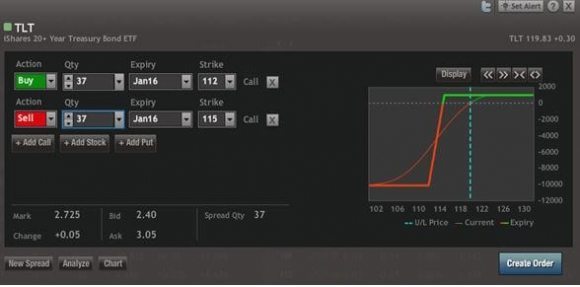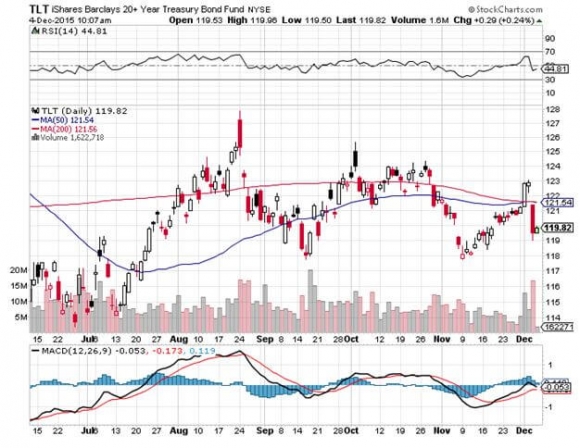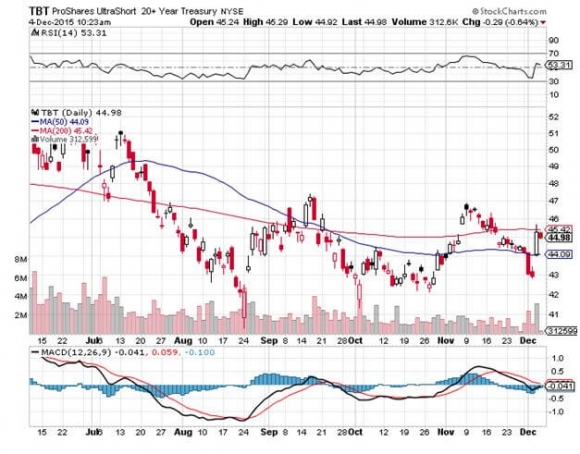As a potentially profitable opportunity presents itself, John will send you an alert with specific trade information as to what should be bought, when to buy it, and at what price.
Trade Alert - (TLT)- BUY-UPDATE
BUY the iShares Barclays 20+ Year Treasury Bond Fund (TLT) January, 2016 $112-$115 in-the-money vertical bull call spread at $2.70 or best
?RISK ON?
Opening Trade
12-4-2015
expiration date: January 15, 2016
Portfolio weighting: 10%
Number of Contracts = 37 contracts
This is a bet that the ten-year Treasury bond yield will not rise above 2.50% by the January 15, 2016 expiration. At the time of this Trade Alert the yield was 2.29%.
OK, OK, I know, I know.
You must thing that I?m suddenly consuming California?s largest cash crop?(it?s not almonds) wanting to buy Treasury Bonds (TLT) here? RIGHT IN FRONT OF THE FIRST INTEREST RATE HIKE IN A DECADE!
However, there is a method to my madness. THERE ALWAYS IS. And for that you have to go to the charts.
When the Treasury market boosted the ten-year yield from 2.05% to 2.35%, which it has done over the past month, it fully discounted a 25 basis point increase by the Fed on December 16. So, already it?s in the price. It is known.
The final nail in the coffin on the rate rise question was this morning?s blockbuster 211,000 November nonfarm payroll and the headline 5.0% unemployment rate that followed.
That leaves the remaining pressure of rising European bond prices and falling yields as the remaining principal pressure on the bond market. And that buying will support American bond prices here.
A hedge fund can buy the (TLT) here at a 2.29% yield and sell short German ten-year bunds at 0.68, and pick up 1.61% per annum. Multiply that tenfold, as hedge funds are wont to do, and the profits increases to 16.1%. And their short side is in a naturally depreciating currency, the Euro.
Nice!
With Wall Street now laying off tens of thousands of bond traders to cut costs, the industry bet is that tortuously low volatility in the fixed income area will remain a chronic condition.
This augurs well for the iShares Barclays 20+ Year Treasury Bond Fund (TLT) January, 2016 $112-$115 in-the-money vertical bull call spread.
Mind you, I have not suddenly fallen in love with bonds.
I am certain we have only just entered a 30-year bear market in this troubled asset class. I just don?t think things are going to fall apart in a hurry.
That?s why I counseled investors to keep their positions in the ProShares Ultra Short 20+ Treasury Bond Fund (TBT). It may take months, but this ETF should hit $48 sometime in the first quarter of 2016. With this fund, you are not in the sites of the monthly option expiration calendar.
The way I see this bear market unfolding is for the markets to discount rate rises 25 basis points at a time. We just spent a year largely trading in a 1.95% 2.35% yield range.
We won?t see the market break out to the upside and trade in a 2.35%-2.60% range until it starts to discount the next 25 basis point hike. That won?t happen until March, or June at the earliest.
All of this adds up to making the iShares Barclays 20+ Year Treasury Bond Fund (TLT) January, 2016 $112-$115 in-the-money vertical bull call spread a total lay up.
If you are uncertain on how to execute an options spread, please watch my training video on ?How to Execute a Bull Call Spread? by clicking here at http://www.madhedgefundtrader.com/ltt-executetradealerts/
The best execution can be had by placing your bid for the entire spread in the middle market and waiting for the market to come to you. The difference between the bid and the offer on these deep in-the-money spread trades can be enormous.
Don?t execute the legs individually or you will end up losing much of your profit. Spread pricing can be very volatile on expiration months farther out.
Here are the specific trades you need to execute this position:
Buy 37 January, 2016 (TLT) $112 calls at????.???$7.70
Sell short 37 January, 2016 (TLT) $115 calls at????....$5.00
Net Cost:????????????????..??.?.....$2.70
Potential Profit: $3.00 - $2.70 = $0.30
(37 X 100 X $0.30) = $1,110 or 1.11% profit for the notional $100,000 portfolio.






